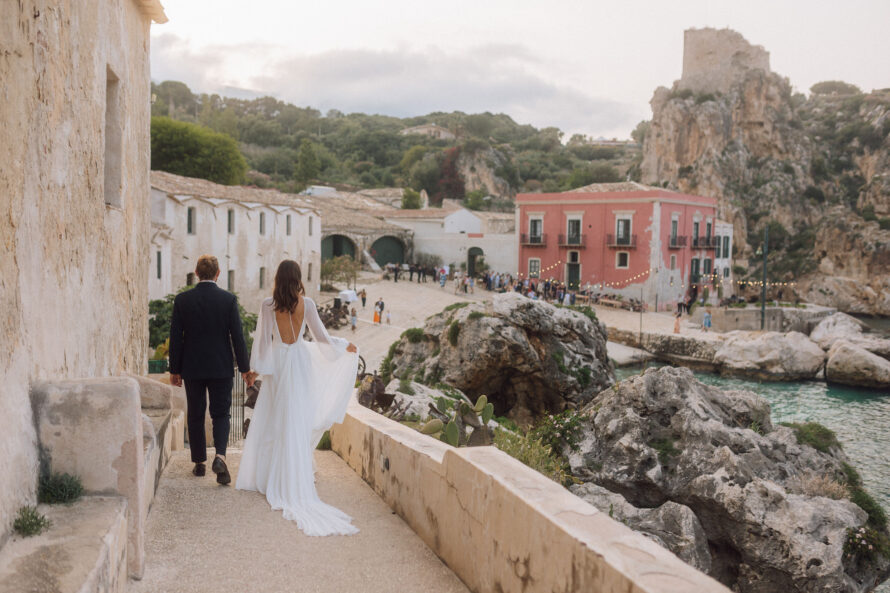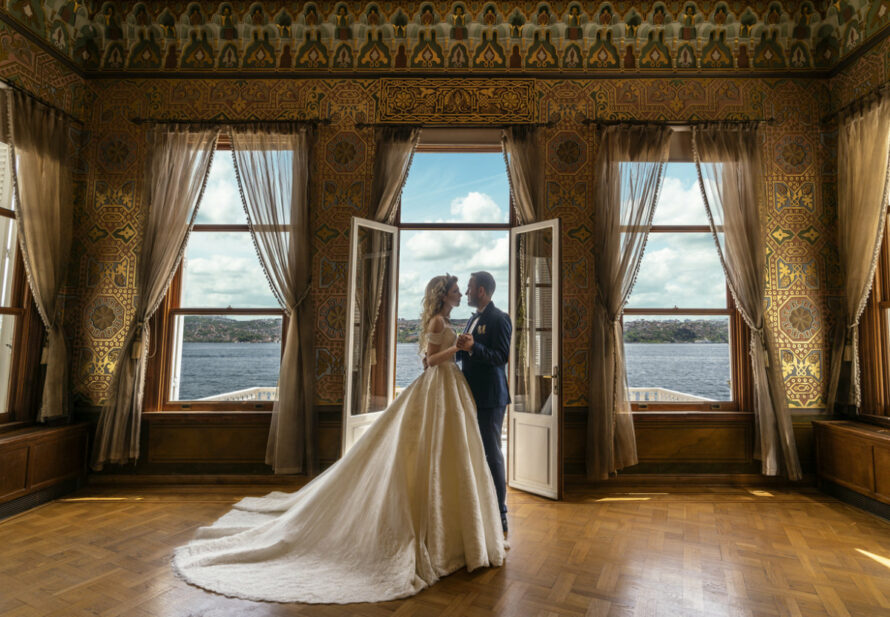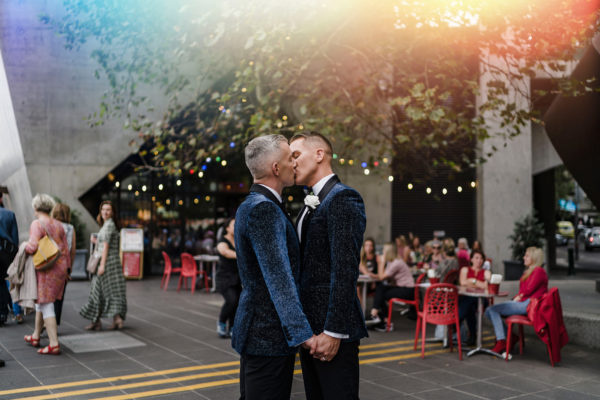When a pair of My Kitchen Rules contestants decide to marry at your wedding venue, you know the menu is going to face plenty of scrutiny.
Fortunately, Darren King was well up to the challenge.
The West Australian born and bred head chef works at Perth’s RiverBank Estate Winery, which hosted the secret nuptials of Series 3 favourites Megan Woodman and Andy Appleby.
With the couple showcasing their love of seafood on the hit reality TV show, it was no surprise their passion filtered through to requests for the three-course sit-down menu.
Of course Darren and his team delivered, with the creation of such dishes as grilled pink snapper served on a bed of Japanese potato salad with garlic tiger prawns and lemon caper vinaigrette.
You can watch a video from their big day here, but the final word goes to Megan, who says: “The whole day was just exactly how I’d imagined. It was perfect.”
Restaurant manager Nicola Heyes – who works with wedding co-ordinators Anna Trovarelli and Bev Gobby – concurs.
“Because they were foodies, we had to be really conscious of the menu, and it’s a challenge the chef really enjoyed,” she said. “Happily, they loved it, they really loved it, which is something we want for all of our couples.”
Still thrilled by the exposure, Nicola believes it’s also a pointer to something she holds dear, which is that the best weddings treat their venue as a wonderful canvas on which to build a unique and personal celebration.
She shared some ideas on how exactly to do this.
Create food, glorious food
Nicola, who offers specialised wedding menus for up to 120 guests sit-down and 150 for substantial cocktail-style, says food “can either make or break” a wedding.
The venue is important, but if the food isn’t up to scratch, it can really have an impact on the atmosphere. And it’s something that modern couples absolutely recognise.
“We find these days that people who inquire about weddings are really interested in the food,” she says. “They want to know what they’re getting and they want to know what they can create.”
The ultimate idea is to shape a menu that captures your personality in a way that is enticing and adventurous and makes a statement. This could be a preference for poultry over game or seafood, a focus on a purely vegetarian offering, or a bent towards food with an edge.
By doing it thoughtfully, you can fashion a culinary journey that caters to a wide variety of tastes and leaves guests nodding their head in recognition.
Looking at canapés, for example, a couple whose love of seafood is well known (such as Megan and Andy) could channel their inspiration into such dishes as salmon on croutons with crème fraiche, almond fried tiger prawns or fish croquettes.
For dinner, meanwhile, a couple who’s never set foot inside a vegetarian restaurant could curate a meat-lovers’ feast, from slow braised pork belly, crispy crackle pickled pork salad and apple cider puree to a braised shank of lamb with de puy lentils, mash potato and mint gravy.
The alcohol, similarly, can be also be a real talking point, especially if you’re marrying at a destination such as RiverBank, which focuses exclusively on its own wines, with intriguing names – and stories – such as jailbird red and chenin blanc.
“Alcohol is such an important part of a celebration, offering just the right accompaniment to the array of food and signposting important moments, such as the toasts. But choosing the right combination is not something that necessarily comes naturally,” Nicola says.
What you often find is that people are unsure about which way to go, as they know what they like – and probably have some idea of great French champagnes for toasting – but are conscious of the fact they’re choosing for everybody, from people who really know their vintages to others who are happy with simple classifications such as red or white.
One helpful idea is to have a wine tasting, not least of all to pick the brains of an expert in food matching, who can also give an insight into complementary beverages such as beer or cider.
“We actually encourage people to come and do that here,” Nicola says. It’s just one more little piece of the puzzle that goes into putting on a perfect and thoughtful celebration. Done properly, the end result is a menu that’s very new, very you and a conversation starter in itself. After all, who can resist looking at the plate beside them and then leaning over to ask: “Oh gosh, that looks amazing. Can you tell me what it is?”
Plan for ambience
Modern weddings run the gauntlet from the effortlessly casual to the sophisticated and elegant. And capturing the mood begins with the smallest details, running right through to the largest moments. The first, and biggest choice, is the wedding venue, and for modern couples, the perfect option is not always inside the four walls of a church. Instead, their focus can shift to somewhere that is a destination and a talking point in its own right, as Nicola knows firsthand.
“Because of our setting within a winery, we actually had wedding inquiries before we started hosting them,” she says.
“People would come here and go ‘Wow, we didn’t realise the setting was so beautiful with such panoramic views.’ They were really blown away.”
Other popular locations for modern ceremonies include heritage homes, private gardens, on the beach or in a restaurant. Weather permitting, the great outdoors is an increasingly favoured choice, whether it’s on a lawn or under a marquee. Both create ample opportunity for individuality, from obvious choices such as flowers and aisle runners to less subtle options such as chairs.
Here, current trends stretch across everything from mismatched seats sourced from op shops to the ever-popular Tiffany design. Other pieces of furniture that can enhance a mood range from antique tables for the signing of the wedding certificate to old-fashioned lamps that throw extra shade on a dusk ceremony.
The aisle also lends itself to beautiful treatments, from a Hollywood-style red carpet to a line of flower-filled vases. As Anna says: “Everybody has their own ideas and themes for the wedding, which is important, as it means every wedding is totally unique. Even if you just bring in a single piece of furniture, or a single blast of colour, it can change the venue completely.”
Then, it’s just about creating the final focal point for the ceremony – besides the wedding party itself of course, For example, if you’re marrying somewhere like a vineyard, a position overlooking valleys and vines will serve as adornment enough.
But if you’re marrying somewhere lush but nondescript, such as a park, elements such as flowers in urns, which can then be transferred to the reception, make a wonderful signature statement.
Think about the seating
The idea of a seating layout is something that should take precedence before you even think about who will sit with whom.
And it’s a great way to help shape the atmosphere of the night. For a celebration that will bring together great groups of friends, rectangular, round or trestle tables that cater for six to eight people provide a great opportunity for conversations within a group, perhaps allowing for a few new faces.
However, another idea to consider, especially if you have a lot of singles, is one long table. This spares awkward divisions, saves the ignominy of a singles table and also gives people proximity to at least five other guests with whom to strike up a conversation.
“It’s all about flexibility,” says Bev, who notes RiverBank’s veranda area, for one, can sit 110-120 people comfortably. “You want to bring people together to build that enjoyment and build that camaraderie.” And if you can get the seating arrangements right, you’re most of the way there. Other ideas include sitting similar age groups together, or linking up people you’ve always thought would get on like a house on fire.
Devise a range of spaces
Another great way to create a truly unique celebration is to structure the day as an actual journey, especially if you have exclusive use of the venue, as you get at RiverBank. The idea is to lead guests through a series of inviting spaces, with a fresh vibe and feel in each one. For starters, make use of the entrance to the ceremony venue.
If guests have to travel through the indoors to the out, make a bold statement of welcome with a sign, a gorgeous floral arrangement or even a table of buttonholes or boutoinneres. If, however, they move straight into the place where the vows will take place, carefully mark the start of the aisle, with directions on how to arrange themselves, whether it’s a chalkboard advising them to pick a seat not a side or a request to form a casual semi-circle around where the wedding party will stand.
Afterwards, have a spot for group shots already picked out, as well as an area where guests can begin to mingle and catch up over a cocktail or canapé. From there, move them into the reception area, making it a group arrival so as to ensure maximum impact from the colours, the decoration and the lighting. It will ramp the mood up just that little bit more ahead of the bride and groom’s arrival.
“The best idea is to have a really good look at the space and see how you can utilise it,” says Nicola, who notes RiverBank’s family friendly indoor and outdoor spaces make it wet-weather proof. Other spaces to look for include a good hangout for kids, a place for older guests to enjoy a seat away from the action, and somewhere the bride and groom can grab a 10-minute breather.
Again, it comes back to the idea of taking a single venue and turning it into a feast of exploration and surprise.
At the end of the day, Nicola – who encourages couples to have photos taken at the bottom of the vineyard near the river – says it’s the personal touches, and shades of personality, that turn a wedding into your wedding.
It’s a day that takes so much effort, so it’s important for the bride and groom to feel like it’s a real reflection and celebration of their love story.
“That way, it’s a day where they can always look back and think ‘Boy, we had such a wonderful time,” she says.


